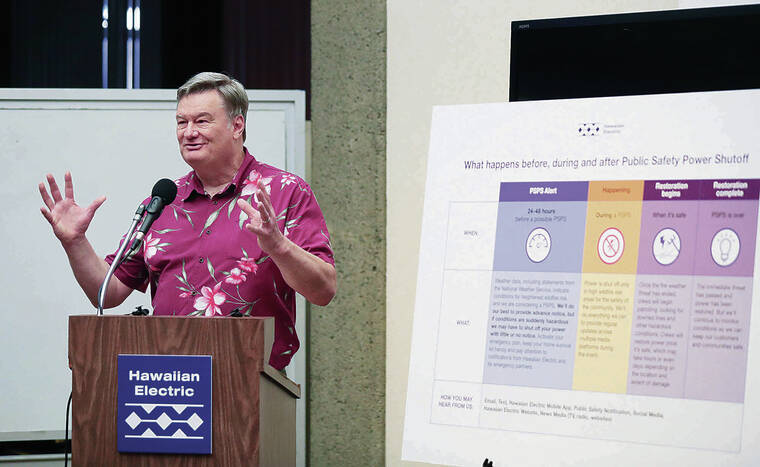Honolulu panel addresses Hawaiian Electric’s power shut-off plan
In areas of the state prone to windstorms, drought and wildfires, Hawaiian Electric plans to implement its Public Safety Power Shutoff, or PSPS, program.
Starting July 1, Hawaiian Electric says it will cut off power to its customers when conditions prove too hazardous to life and property.
ADVERTISING
Those actions will occur on red-flag warning days, as determined by the National Weather Service, when warmer temperatures, lower humidity and stronger winds could produce an increased risk of fire danger. These actions also follow the deadly Aug. 8 Maui wildfires, which destroyed most of Lahaina.
According to Jim Alberts, Hawaiian Electric’s senior vice president and chief operations officer, wildfires are a top hazard facing Hawaii.
“Hawaiian Electric has responded with a multi-pronged approach to mitigating wildfire risk. One component is proactively shutting off power, which is a last line of defense to protect the community,” Alberts said in May in a written release. “We understand shutting off power can create hardships for affected customers, so this is not something we take lightly.”
Hawaiian Electric, the state’s largest electrical utility, says power shut-offs mainly would occur along Oahu’s Waianae Coast — a part of the island historically prone to wildfires — and affect about 2,700 customers. Similar power shut-offs on Maui and Hawaii Island could affect a combined 45,400 customers, the company adds.
“So under certain conditions, in order to mitigate wildfire risks from their electrical infrastructure, Hawaiian Electric would shut off power in known, high-risk areas based on local geographic conditions as well as the characteristics of the electrical system in those areas,” city Emergency Management Director Hiro Toiya told the Citizens Advisory Commission on Emergency Management on Thursday morning.
Areas on Oahu where underground utilities exist likely will not see power cut, Toiya said.
“But if it’s overhanging utility power lines on wooden poles, and there’s a lot of vegetation in the area, and there’s strong winds, it may make sense for them to shut off power preemptively in those areas,” he said.
Hawaiian Electric will have “specific conditions for each part of the grid as far as what the triggering wind speeds, humidity and other conditions might be,” he said.
“So it’s not going to be a one-size-fits-all kind of approach, based on a red-flag warning from the National Weather Service,” he added. “The issuance of a red-flag warning does not equate to HECO turning off power in these areas.”
Still, Toiya said concerns for the city are “essentially twofold.”
“One is related to the impacts to critical infrastructure, and hence the impacts to lifelines that people are dependent on and that public safety agencies are dependent on,” he said.
That includes the city’s critical services like communications as well as its water supply system.
“If there’s no power to a water-pumping station, then that would affect not only the ability for individuals to access water, but also the ability for firefighters to access water, in some cases, when we’re dealing with a high wildfire risk scenario,” he said.
The second involves impacts to Oahu’s most vulnerable populations “and those who may be dependent on power to sustain life,” Toiya said. “For those who are power-dependent to sustain life, of course, that could be a life-threatening situation.”
He noted threats like hurricanes or a cyberattack could knock out the island’s power grid at any time.
“We all collectively need to be prepared for a power outage, but the difference here is that it has the potential to be a prolonged impact that happens in anticipation of a significant event,” he said.
Hawaiian Electric did not speak at Thursday’s commission meeting.
Commissioner Lani Hubbard said Hawaiian Electric’s power shut-offs will affect low-income people with chronic medical issues.
“It’s easy to say, ‘Oh, get a generator,’ but you’re dealing with a socially disadvantaged population, and there are concerns with ventilator support, with oxygen, especially if you’re talking days (without power),” she said.
She added that “the other option is evacuate.”
“But again, that’s easier said than done,” she said. “We have patients that are bed-bound, and gurney transport would be the only way to get them to a different location. I just wonder about these really medically frail patients that are really going to be impacted by this.”
Toiya said city resources might have difficulty responding during PSPS events.
“We could set up public shelters, but we’re not set up with health care services at these shelters,” he said. “It could be Red Cross volunteers or city employees who don’t have any kind of medical training, and meanwhile other essential services have to continue.”
Hubbard asked, “And how much advance notice is the community going to be given?”
Toiya said it depended on the weather, “so to whatever extent the National Weather Service can give us forecasts for high winds and dry conditions,” he said, but added, “We don’t have a whole lot of heads-up warning on these (conditions).”
Hawaiian Electric says it plans to provide 24- to 48-hour notice before any PSPS.
“But if conditions are suddenly hazardous we may have to shut off your power with little or no notice,” the company states. “Activate your emergency plan, keep your home survival kit handy and pay attention to notifications from Hawaiian Electric and its emergency partners.”
“Crews will restore power once it’s safe, which may take hours or even days depending on the location and extent of damage,” the company states.
Hawaiian Electric says it’s also taking steps to mitigate potential hazards, including advancing its $190 million grid resilience plan to harden against wildfires, hurricanes, tsunamis and flooding, and adapt to climate change.
“Half of this multi-year program is to be paid by the federal government with the other half matched by customers,” the company states.





